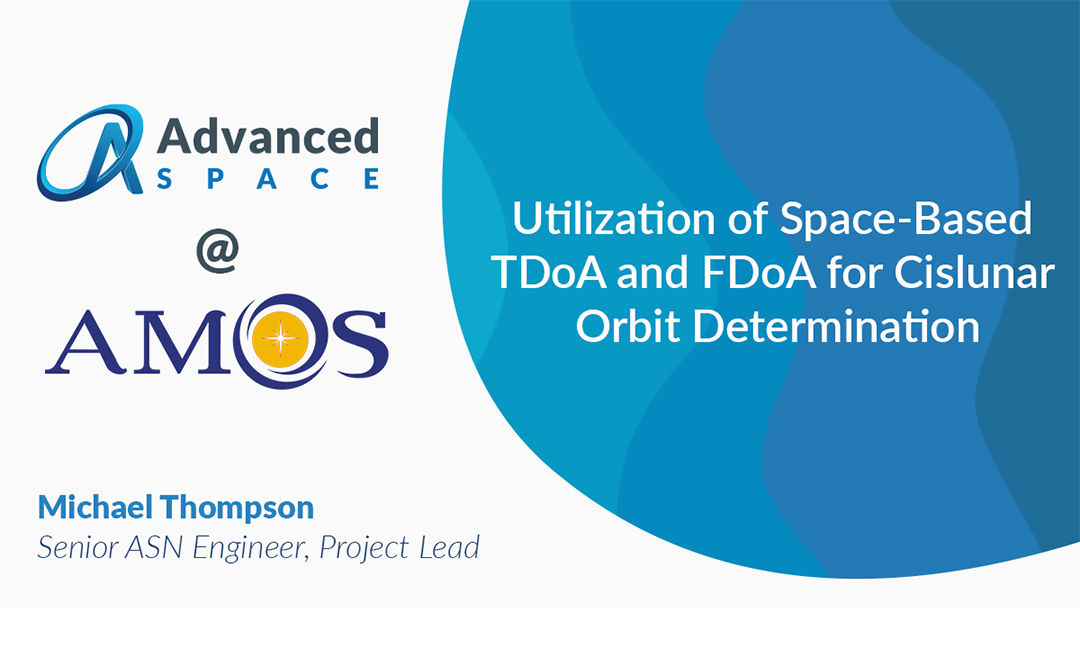Presented at the Advanced Maui Optical and Space Surveillance Technologies (AMOS)
Michael R. Thompson, Matthew D. Popplewell, Bradley Cheetham
ABSTRACT
This study evaluates the potential observability benefits of space-based passive RF systems compared to other ground-based and space-based observers for cislunar Space Domain Awareness. TDoA and FDoA observations are used for orbit determination of objects in the lunar vicinity using observers in GEO and XGEO. The results are compared to ground-based observations in order to analyze the performance gains over existing architectures. Results show using space-based systems result in faster filter convergence and more accurate state estimates.
Introduction
Over the past decade, the space industry has seen a renewed interest in new space missions about the Moon and in cislunar space. Already several organizations have placed vehicles in cislunar space such as NASA’s Lunar Reconnaissance Orbiter in 2009 and China’s Chang’e-5 in 2020. Furthermore, NASA’s Artemis program aims to enable the return of humans to the Moon by 2024 with plans for supporting space architecture, such as the Lunar Gateway. As the number of space objects in cislunar space increases, so too does the need for an improved understanding of how to reliably track such objects. Current Space Domain Awareness (SDA) capabilities are primarily concerned with Earth-centered objects. The European Space Agency (ESA) estimates about 31,450 debris objects tracked by the Space Surveillance Network (SSN) [1]. However, the existing ground-based architecture is illsuited for growing operations in the cislunar domain. Complex nonlinear dynamics, body occultations, lunar exclusions, poor geometric observability, and low signal-to-noise ratio (SNR) observations complicate cislunar SDA [2]. A potential alternative is employing space-based platforms to supplement or replace ground-based platforms. Prior work has demonstrated the ability to perform orbit determination (OD) via optical measurements between two cislunar spacecraft [3]. This study expands this analysis to the utilization of time difference of arrival (TDoA) and frequency difference of arrival (FDoA) measurements.
Using ground-based receivers for orbit determination of cooperative spacecraft transmitting radio frequency (RF) signals has been employed for several decades. Ground stations have access to stable timing sources and can yield large baselines with stations separated by thousands of kilometers, resulting in precise measurements. The Deep Space Network’s (DSN) delta-differential one-way ranging (ΔDOR), which uses measurements of both the spacecraft and quasars to calibrate for instantaneous atmospheric conditions and provide plane-of-sky information, can produce measurements as low as single digit nanoradians. Assuming the downlink signal strength is adequate, TDoA and FDoA can also be used with non-cooperative spacecraft.
In domains where the use of ground-based platforms are stressed, the use of space-based TDoA and FDoA observations of an RF-emitting resident space object (RSO) can supplement ground systems. Passive RF systems do not have the exclusion constraints of optical systems or the power requirements of active radar systems. Additionally, the TDoA and FDoA OD methodology can be used to estimate the state of almost any transmitting RSO, with no special downlink radio configurations required.
This study demonstrates the observability performance of space-based TDoA and FDoA observations of RF-emitting RSOs in cislunar space. Orbit determination of spacecraft in the lunar vicinity using TDoA and FDoA is performed by observers in GEO and cislunar orbits. Measurements are simulated in a high-fidelity dynamical environment and orbit determination setup for multiple cases.
References
[1] European Space Agency, “Space Debris by the Numbers,” 2022.
[2] M. Bolden, T. Craychee, and E. Griggs, “An Evaluation of Observing Constellation Orbit Stability, Low Signal-to-Noise, and the Too-Short-Arc Challenges in the Cislunar Domain,” 2020.
[3] M. R. Thompson, N. P. Ré, C. Meek, and B. Cheetham, “Cislunar Orbit Determination and Tracking via Simulated Space-Based Measurements,” 2021.
